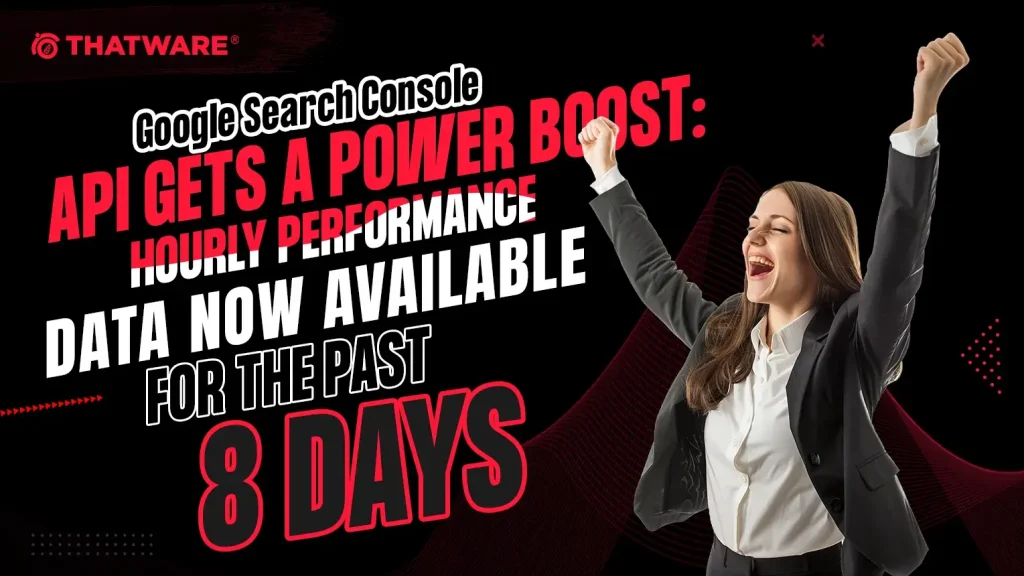SUPERCHARGE YOUR ONLINE VISIBILITY! CONTACT US AND LET’S ACHIEVE EXCELLENCE TOGETHER!
In the ever-evolving world of digital marketing and search engine optimization (SEO), data is king. Having timely, accurate, and detailed insights into how your website is performing in Google Search is crucial for optimizing visibility, improving user engagement, and ultimately driving business success. With this in mind, Google’s latest update to the Search Console API, announced on April 9, 2025, is a game-changer.
The update allows developers, webmasters, and SEO professionals to programmatically access hourly performance data from Google Search for the past eight days. This represents a significant improvement over previous capabilities and aligns with Google’s ongoing mission to make Search Console more powerful and accessible for data-driven decision-making.

Let’s take a deeper look at what this update means, how it fits into the evolution of Search Console, and how web professionals can leverage this new data access to enhance their SEO strategies.
A Brief History of Hourly Data in Google Search Console
To fully appreciate the significance of this update, it’s important to understand how hourly data reporting in Search Console has evolved:
- Pre-December 2024: Google Search Console only provided performance metrics (clicks, impressions, CTR, and position) on a daily basis. This was sufficient for high-level trend analysis, but it lacked the granularity needed for real-time optimization and deep-dive diagnostics.
- December 2024: Google introduced hourly data visibility in the web interface of Search Console’s Performance report. This allowed users to view hourly performance data for the most recent 24-hour period. The primary use case was to monitor the immediate impact of content publication, site updates, or sudden traffic shifts.
- January 2025: An export button was added to the web interface, enabling users to download hourly performance data and analyze it further using spreadsheet tools or business intelligence platforms.
- April 9, 2025: Google extended this functionality to the Search Console API, enabling programmatic access to hourly data for the past eight days.
This latest update represents a significant step forward, particularly for developers and SEO analysts who rely on automated workflows and custom dashboards to monitor site health and search performance.
What’s New in the Search Console API Update?
The headline feature in the April 2025 update is simple but powerful: You can now retrieve hourly-level performance data for your site from the past 8 days via the Search Console API.
Key Features:
- Granular Insights: Get performance data broken down by the hour rather than just daily summaries.
- Extended Timeframe: View up to 192 hours (8 days) of performance data in hourly increments.
- Programmatic Access: Integrate this data directly into your analytics tools, dashboards, or automated reporting systems via the API.
- Real-Time Monitoring: Quickly assess how your site is performing in near-real-time following major content updates, technical changes, or trending events.
Why This Matters: Benefits of Hourly Data Access
1. Real-Time Performance Monitoring
With hourly data, you can now see how your site is performing with minimal delay. This is especially useful in scenarios where time-sensitive content is published, such as:
- News articles
- Seasonal promotions
- Product launches
- Trending blog posts
Instead of waiting a full day to evaluate performance, you can start analyzing engagement patterns within hours.
2. Faster Troubleshooting
If your website experiences a sudden drop in traffic, hourly data can help pinpoint when the issue began. Was it a gradual decline or a sharp drop at a specific time? This insight can be instrumental in identifying the root cause, whether it’s:
- A technical issue (like a server outage)
- Google algorithm changes
- Indexing problems
- External factors like competitor activity
3. Improved A/B Testing and SEO Experimentation
For SEO professionals conducting experiments, being able to analyze traffic and CTR variations on an hourly basis provides immediate feedback on the impact of:
- Meta title and description changes
- Structured data implementation
- Internal linking adjustments
- New content placements
Hourly data enables quicker iteration and more responsive optimization efforts.
4. Enhanced Reporting Capabilities
By pulling hourly data into custom dashboards using tools like Google Data Studio, Looker, or Power BI, stakeholders can receive:
- More detailed visualizations
- Immediate alerts based on thresholds
- Dynamic performance comparisons (e.g., comparing this Tuesday 9-10 a.m. with last Tuesday’s same hour)
5. More Accurate Campaign Attribution
If your site is running time-bound marketing campaigns — for example, email blasts, social media pushes, or influencer partnerships — hourly data allows you to correlate spikes in traffic more precisely to the timing of these activities.
How to Use the New Hourly Data in the Search Console API
Getting Started
To use this new feature, developers should update their integration with the Search Console API to request performance data using hourly granularity. Here’s how:
- Set Up Your API Project: Ensure you have access to the Google Search Console API.
- Authorize API Access: Use OAuth 2.0 to authorize your application to access Search Console data.
- Construct Your Query:
- Use the searchanalytics.query method.
- Set the dimensions parameter to include date and hour.
- Specify the date range (within the last 8 days).
- Parse the Response: The returned JSON data will now include performance metrics for each hour of the day, for each date in your specified range.
Example API Request
json
CopyEdit
{
“startDate”: “2025-04-01”,
“endDate”: “2025-04-08”,
“dimensions”: [“date”, “hour”],
“rowLimit”: 1000
}
This request would return hourly performance data from April 1 to April 8, 2025.
Setting Up the Search Analytics API with Hourly Data Feature
To leverage the new hourly data feature in the Search Analytics API, follow these steps:
- Enable the Search Console API:
- Visit the Google Cloud Console.
- Create a new project or select an existing one.
- Navigate to the “APIs & Services” > “Library” section.
- Search for “Google Search Console API” and click “Enable
- Set Up Authentication Credentials:
- In the “APIs & Services” > “Credentials” section, click on “Create Credentials.”
- Choose “OAuth 2.0 Client IDs” or “Service Account” based on your application needs.
- Follow the prompts to configure the consent screen and download the credentials file.
- Install the Google API Client Library:
- For Python, install the client library using pip:
Authorize and Build the Service Object:
4. Use the downloaded credentials to authenticate and build the service object:
- Construct the API Request:
Define the request parameters to fetch hourly data. Ensure that the dataState parameter includes fresh data to access the most recent metrics:
Execute the Query:
- Make the API call to retrieve the data:
- response = service.searchanalytics().query(siteUrl=’https://www.yoursite.com’, body=request).execute()
Process the Response:
- Iterate through the response to access the hourly data
By following these steps, you can programmatically access and analyze your website’s hourly performance data for the past eight days, enabling more responsive and informed SEO strategies.
Limitations to Keep in Mind
While this update is powerful, it’s important to understand a few limitations:
- Historical Data is Limited: Hourly data is only available for the last 8 days. If you don’t capture it during that time, it’s lost.
- Sampling May Apply: For very large sites, Google may sample the data, especially if your queries are complex or cover a wide range of dimensions.
- Data Delay: Although hourly data is relatively fresh, it’s not real-time. There may be a slight delay (usually a few hours).
- API Quotas: Be mindful of Search Console API usage quotas to avoid hitting daily limits.
Best Practices for Using Hourly Search Console Data
To make the most of this new functionality, consider the following best practices:
- Automate Data Collection: Set up a cron job or serverless function to pull data every day to ensure you don’t lose access to older hourly data.
- Use Data Warehousing: Store retrieved data in a structured format (e.g., BigQuery, PostgreSQL) to enable historical comparisons.
- Integrate with Alerting Tools: Create real-time alerts for unusual traffic patterns using thresholds or machine learning models.
- Visualize Strategically: Focus on time-series charts, heatmaps, and anomaly detection to make insights more actionable.
- Correlate with External Events: Tie hourly search data with analytics, ad campaigns, social media activity, or even server logs to build a more complete performance narrative.
The Bigger Picture: Google’s Vision for Search Console
This update is part of a broader trend of democratizing access to real-time search data. By allowing developers and marketers deeper visibility into their performance metrics, Google is encouraging a more agile, responsive, and data-savvy web ecosystem.
More frequent and detailed insights empower site owners to act quickly, whether to optimize content, resolve technical issues, or capitalize on trending search behavior. As competition for search visibility grows, these advantages can make a substantial difference in traffic and conversions.
Conclusion
The April 9, 2025 update to the Google Search Console API marks a significant advancement in how we access and utilize performance data. With hourly-level granularity now available for the past eight days, developers, SEOs, and digital marketers have an invaluable tool at their fingertips.
From faster diagnostics to more precise reporting and real-time monitoring, the possibilities are vast. Whether you’re running a news website, managing SEO for an e-commerce platform, or building data-driven applications, this update gives you the power to see your search performance like never before.
As Google continues to enhance its API offerings, staying on top of these changes is essential. It’s time to embrace hourly data and elevate your SEO game to the next level.

Thatware | Founder & CEO
Tuhin is recognized across the globe for his vision to revolutionize digital transformation industry with the help of cutting-edge technology. He won bronze for India at the Stevie Awards USA as well as winning the India Business Awards, India Technology Award, Top 100 influential tech leaders from Analytics Insights, Clutch Global Front runner in digital marketing, founder of the fastest growing company in Asia by The CEO Magazine and is a TEDx speaker and BrightonSEO speaker.

